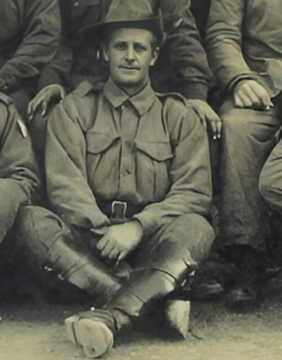GRIGGS, Herbert Matthew
| Service Number: | 619 |
|---|---|
| Enlisted: | 6 October 1914, Leongatha, Vic. |
| Last Rank: | Private |
| Last Unit: | 8th Light Horse Regiment |
| Born: | Geelong, Victoria, Australia, 30 December 1881 |
| Home Town: | Malvern East, Stonnington, Victoria |
| Schooling: | Not yet discovered |
| Occupation: | Farmer |
| Died: | Nyah, Victoria, Australia, 11 November 1947, aged 65 years, cause of death not yet discovered |
| Cemetery: |
Nyah Cemetery, Victoria |
| Memorials: | Hallston and District WW1 Roll of Honor |
World War 1 Service
| 6 Oct 1914: | Enlisted AIF WW1, Private, 619, 8th Light Horse Regiment, Leongatha, Vic. | |
|---|---|---|
| 12 Feb 1915: | Involvement Private, 619, 8th Light Horse Regiment, --- :embarkation_roll: roll_number: '2' embarkation_place: Melbourne embarkation_ship: HMAT Armadale embarkation_ship_number: A26 public_note: '' | |
| 12 Feb 1915: | Embarked Private, 619, 8th Light Horse Regiment, HMAT Armadale, Melbourne |
Help us honour Herbert Matthew Griggs's service by contributing information, stories, and images so that they can be preserved for future generations.
Add my storyBiography contributed by Faithe Jones
Mathew Herbert “Bert” Griggs enlisted in Leongatha on 3rd October 1914 aged 34. He was described as 5’8”, fair complexion, blue eyes and light brown hair. Before he left a farewell function was given in his honour at Hallston, where he was given a wrist watch.
He joined the 2nd Reinforcements, 8th Light Horse Regiment. The unit departed Melbourne on the 12th February 1915 on the HMAT Armadale A26 for Egypt and were sent to the Heliopolis Race Course Camp. They were engaged in training until being sent to Gallipoli on 20 May 1915 to operate as infantry, leaving their horses behind.
On 7 Aug 1915, the 8th and 10th Light horse was ordered to attack across The Nek. This battle is the one that the climax of the movie “Gallipoli” was based on. The 8th was divided into two waves, followed by the 10th Light Horse in two waves. It turned into a massacre. Three waves went over the top before the attack was called off. The 8th suffered 372 casualties, 154 killed. The 10th suffered 138 including 80 killed. The casualties of the 8th were almost half of their strength. The bones of the dead lay there on the battlefield until the end of the war. The Nek cemetery covers the no-man land where they died. Of 316 dead only five were identified.
After the battle the remains of the regiment were used in defensive roles for the remaining time on Gallipoli, until the evacuation on 20 December 1915.
Bert was evacuated on 16 Aug 1915 to Heliopolis with Enteritis. He returned to Gallipoli on 15 October 1915 and was officially promoted to Lance Corporal on 1 December 1915. Evacuated with rest of the Anzac forces from Gallipoli 20 December they returned to Egypt on 23 December 1915. Not long after arriving, he was admitted to hospital with jaundice until 26 February 1916.
On 28 February 1916, the 8th Light Horse Regiment moved to join its parent brigade, the 3rd Australian Light Horse Brigade, which was taking part in the defence of the Suez Canal. The work was hot and monotonous. They remained here until moved to the Romani region to bolster the defence of that area.
Coming down with appendicitis on 1 June 1916, Matthew was sent to hospital in Egypt and then was transferred to England for treatment at Harefield Hospital. He was discharged from hospital and marched into No. 2 Command depot 1st December 1916 but was returned to Australia on the HMAT Ulysses on 12th April 1917. He was discharged Medically Unfit with Gastritis and Melancholia on 22 June 17 and was returned to Australia on the HMAT Ulysses on 12th April 1917.
Courtesy of Avenel Jane









